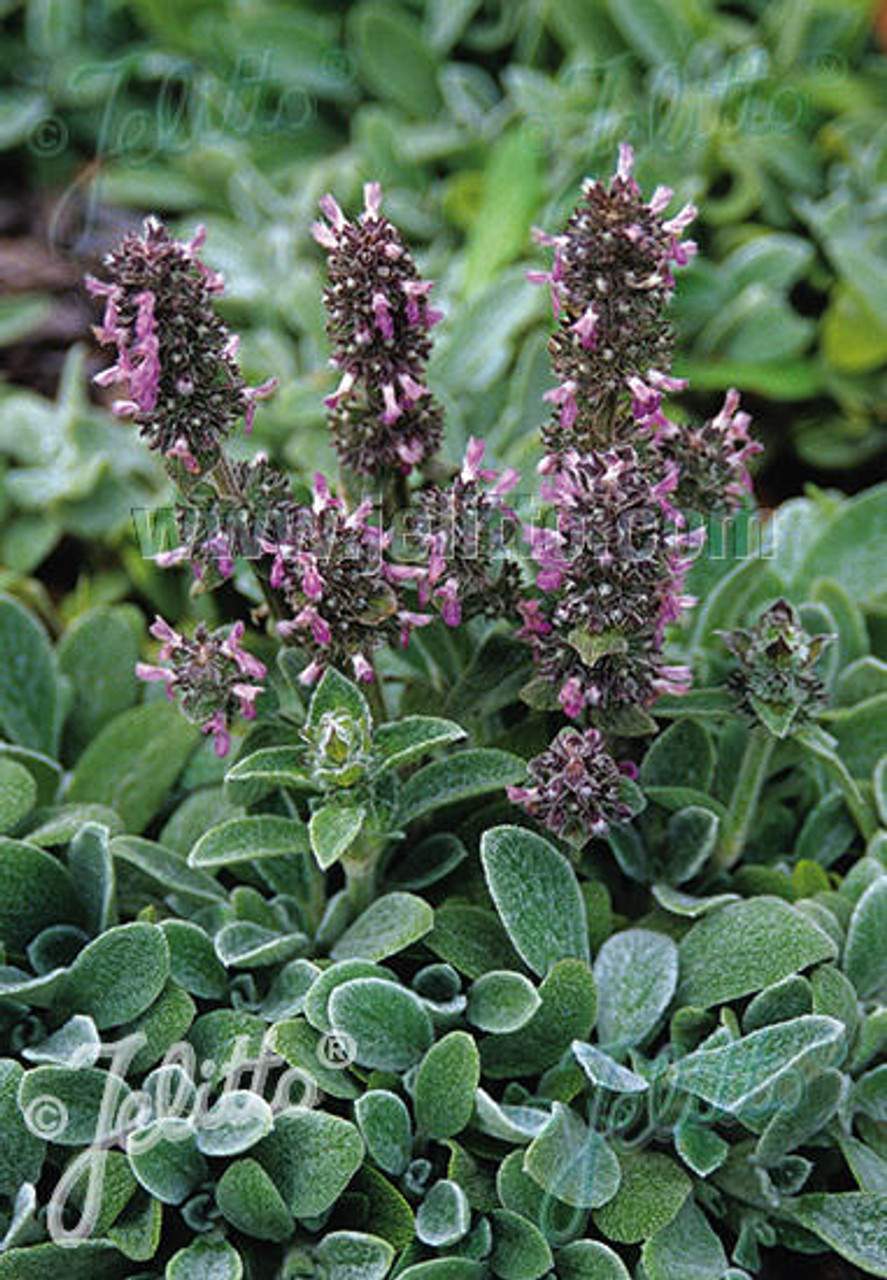Product Description
Stachys byzantine 'Silky Fleece' (10)ct Flat
Stachys byzantina 'Silky Fleece', also known as dwarf lamb's ears, is a compact cultivar of the popular lamb's ears plant. Here are its characteristics:
Common Name: lambs' ears
Type: Herbaceous perennial
Family: Lamiaceae
Zone: 5 to 8
Height: 2 - 3 inches
Spread: 6 - 10 inches
Bloom Time: May to July
Bloom Description: Lavender
Full sun
Water: Dry to medium
Maintenance: Low
Suggested Use: Ground Cover, Naturalize
Tolerates: Rabbit, Deer, Dry Soil, Shallow-Rocky Soil, Black Walnut, Air Pollution
Stachys byzantina 'Silky Fleece' is a dwarf cultivar of the popular Lamb's Ears plant, prized for its incredibly soft, velvety, silver-gray foliage and compact growth habit. It is a fantastic addition to gardens, providing textural contrast and a soothing presence.
- Foliage: The standout feature is its dense, tongue-shaped leaves covered in a thick layer of silky, silvery-gray hairs. The foliage forms a low-growing mat that is irresistible to touch.
- Flowers: It occasionally produces small, pink-purple flower spikes in summer, but the foliage is the main attraction. Many gardeners prefer to remove the flower stalks to maintain the focus on the silvery foliage.
- Growth Habit: It forms a compact clump that typically grows 4-6 inches tall and spreads 12-18 inches wide. It spreads slowly by runners, making it a well-behaved groundcover.
- Hardiness: It is hardy in USDA zones 4-8, tolerating a wide range of temperatures and conditions.
- Low Maintenance: Once established, it is very low-maintenance and drought-tolerant.
Growing Conditions:
- Sunlight: It thrives in full sun to partial shade. Full sun promotes denser growth and better foliage color.
- Soil: It prefers well-drained soil and tolerates various soil types, including sandy, loamy, and clay soils.
- Moisture: It prefers moderate moisture but is drought-tolerant once established. Avoid overwatering, which can lead to root rot.
Uses in the Landscape:
- Groundcover: Its spreading habit makes it ideal for covering ground, suppressing weeds, and creating a soft, silvery carpet.
- Borders and Edging: It provides a lovely textural contrast to other plants in borders and edges.
- Rock Gardens: It thrives in the well-drained conditions of rock gardens, softening the hard edges of rocks.
- Sensory Gardens: Its soft, velvety texture makes it a delightful addition to sensory gardens.
- Containers: It can be used in containers as a spiller or filler, adding texture and interest.
Additional Tips:
- Pruning: Remove any dead or damaged leaves to maintain a tidy appearance. Flower stalks can be removed if desired.
- Division: It can be divided in spring or fall to propagate new plants or maintain plant vigor.
- Deer and Rabbit Resistance: It is generally deer and rabbit resistant due to its fuzzy foliage.
- Overwatering: Avoid overwatering, as this can lead to root rot and fungal diseases.
Overall, Stachys byzantina 'Silky Fleece' is a charming and versatile groundcover that adds a touch of softness and elegance to the garden. It is incredibly soft, silvery foliage, compact growth habit, and low-maintenance nature make it a popular choice for gardeners seeking a textural and easy-care plant.
Ten (10) plants in 4.5-inch containers per flat (or tray).
Other Details
The most important part of the plant is its root system. Healthy roots are the foundation of a healthy, vibrant plant. The type of plug container used is based on the specific needs of the plants. Perennials offered as bare root traditionally perform better when planted as bare root.Planted in a specialized mix, potted plants have well established root systems. Top growth stage will vary depending on the current life cycle and time of year when shipped. In Winter and early Spring dormant plants may be shipped. Dormant plants may be planted right away, even before the last frost date.
Most bare root varieties are field grown for at least one season, though Hemerocallis and Hosta are grown for two seasons. The bulk of the soil is removed during the harvesting process and the tops of most varieties are trimmed back to the crown. They are graded, packed in shredded aspen or sphagnum moss and stored in freezers until ready to be shipped.
See our Container Sizes and Bare Root Perennials pages for more information.
Plant information and care is provided in the Overview section, Plant Genus Page and general information is provided in the Planting Care & Guides. Additional questions can be asked on each Plant page.
Plant Spacing: Using the maximum mature spread or width of a plant to guide spacing, ensures space to grow to full size. To fill an area sooner, plant them closer together. Just remember, future thinning or transplanting may be needed.
Water: Keep a close eye on newly planted perennials, especially throughout the first growing year. Most early plant loss is due to too much or too little water!





